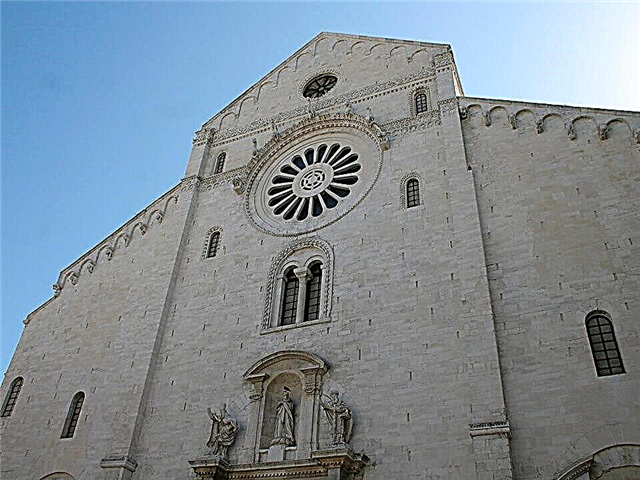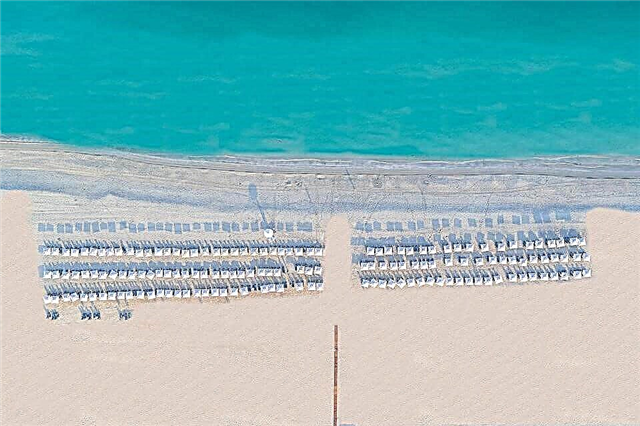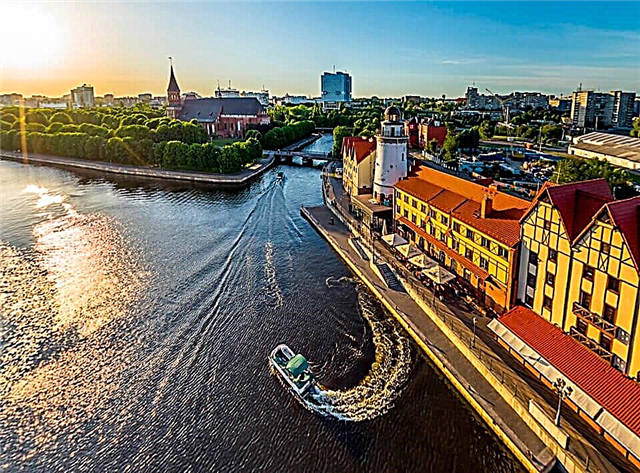Address: Russia, Yaroslavl region, Yaroslavl, st. Chelyuskintsev, 17
Foundation date: 1616 year
Main attractions: Church of Cyril and Athanasius, Church of the Savior Image Not Made by Hands
Coordinates: 57 ° 37'30.9 "N 39 ° 53'43.3" E
Cultural heritage site of the Russian Federation
Content:
Monasteries of Yaroslavl
For four centuries there has been an Orthodox monastery on the Yaroslavl land, dedicated to the revered Christians Saints Athanasius and Cyril of Alexandria. Through the efforts of several generations of talented Russian architects, the monastery has become one of the richest and most expressive architectural ensembles of the central part of the city. Now the Yaroslavl Theological Seminary is located within its walls.
The history of the founding of the Kirillo-Afanasyevsky monastery
Researchers still do not agree on when the Cyril-Athanasiev monastery was founded. There are documents according to which it existed in the 16th century. But most historians insist that the birth of the monastery dates back to 1615.

View of the monastery from Chelyuskintsev street
The monastery is mentioned in the old text, where the church tradition was recorded about the finding of the icon that saved Yaroslavl. In 1612 Yaroslavl people suffered from a terrible pestilence epidemic. At first, the inhabitants of the city wanted to walk along it with the icon of the Tolga Mother of God. She, as believers believed, more than once saved the ancient city from troubles. But Archpriest Ilya, rector of the city's Assumption Cathedral, decided to hold a procession with the old icon of the Savior the Almighty, which was kept in a small wooden chapel. It was located, as the text says, near the "monastery of Athanasius and Cyril."
After the procession, the epidemic stopped and the city was saved. And the picturesque image was recognized as miraculous. A new wooden church was built especially for him in just one day. Such temples in those days were called "common". That is, the old text unambiguously mentions an already functioning monastery.
But there is also another document dated 1615. It contains a request from the head of the local zemstvo Gabriel Myakushkin to Rostov, addressed to Metropolitan Kirill. Residents wanted to receive a blessing for the construction of the monastery in the place where the famous icon was found. Therefore, only one thing can be unambiguously stated - by the time of the petition, the Cyril-Athanasievsky monastery in Yaroslavl already existed.
His dedication to two Orthodox saints was not accidental. These religious ascetics were revered by the church as fighters against heresy and zealots of the Orthodox faith. The beginning of the 17th century coincided in Russia with the invasion of the Polish-Lithuanian army. And in the Time of Troubles, the ministers of Russian churches were especially active in opposing a possible Catholic expansion.
The history of the Kirillo-Afanasyevsky monastery in the 17th-20th centuries
At first, all the monastery buildings were made of wood. Stone construction began in it, as in most of the Yaroslavl monasteries, during the reign of Metropolitan Ion Sysoevich, in the second half of the 17th century. In addition to churches, a stone building for the brethren and powerful walls were erected at the end of the 17th - beginning of the 18th century. We can admire two ancient churches, albeit rebuilt, even now.
By letters of gratitude issued by Tsar Mikhail Fedorovich, the monastery was granted land and a place for its own mill. In addition to them, monks were exempted from part of the taxes. For example, from duties on the export of timber and firewood for their own needs. This gave the monastery an opportunity for further growth and development.

Gate tower
Throughout its history, the monastery has experienced several large fires. The first happened in 1658. And then not a single monastery building was saved from the fire. The second disaster happened in 1670. And almost a century later, in June 1768, a new devastating fire broke out that engulfed all the central streets of the city. However, each time the monastery found funds for restoration. So, in 1768, the frescoes in the cathedral church were renovated, and the old stone iconostasis in it was replaced with a wooden one.
In the 18th century, two low towers were erected on the stone monastery wall. One of them began to be used as the Holy Gates. And in the other, a memorial chapel was erected in honor of the revered icon with the image of the Savior Not Made by Hands. New stone towers were crowned with graceful spiers, on which towered angels with trumpets.
A lot of construction work was carried out in the 20-30s of the XIX century. An urgent building was built on two floors with a large refectory chamber. The dilapidated iconostasis was replaced with a new one, and the warm church was decorated with wall paintings. During these years, the monastery received a huge bell, the weight of which was equal to 115 pounds, from the abolished parish of Borisoglebsk. He became the seventh in the monastery bell ensemble.
At the turn of the 19th and 20th centuries, the monastery was engulfed in a new wave of construction work, affecting the secondary buildings. At this time, new cellars, a stable for horses, a monastery bathhouse, an economic shed and a coach house were erected from stone. And in 1912, the wall paintings were renewed again. For this, the famous painter and restorer Mikhail Ivanovich Dikarev was invited.
Throughout its history, the monastery has never been considered particularly rich and not crowded. According to the documents of the 17th century, it is known that only 7 monks lived in the monastery. After 100 years, their number has remained the same. And by the beginning of the 20th century, the monastery remained the smallest in the diocese in terms of the number of monks. Only 10 inhabitants prayed to God and managed the household here. There were three temples on the territory - two five-domed and one single-domed, as well as two high bell towers. But despite its size, the monastery has always been very revered among the people, and many pilgrims came here.
In 1918, during the White Guard uprising against Soviet power, the monastery, like many buildings in the city, suffered from shelling. Two churches were damaged and one of the residential buildings burned down. A community of parishioners existed in the monastery until its closure in 1925. When this happened, part of the church property was distributed to other churches in Yaroslavl.

Church of the Savior Not Made by Hands
In the 30s of the last century, the ruin continued. Two bell towers were dismantled and the beautiful five-domed Resurrection Church, built in the 17th century, was demolished. The premises of the remaining churches began to be used for various industries and city offices. Here, for example, the administration of a furniture factory was located. And in the building where the monks used to live, the townspeople were settled.
The church buildings and the monastery grounds were returned to the believers only in 2007. By that time, temples and fences had almost collapsed without proper care, windows were shattered in many places, and the territory was filled with piles of rubbish. A year later, listeners of the Yaroslavl Theological Seminary settled in the monastery. Through the efforts of seminarians, monks, professional restorers and volunteer assistants for several years, it was possible to carry out extensive restoration work, which has not yet been completed.
Architectural monuments on the monastery territory
The first stone church of Cyril and Athanasius was erected on the monastery territory in 1664. It was painted by Moscow masters. 12 years later, from the north, a warm temple was added to this church, consecrated in honor of the Metropolitan of Moscow Alexy.
The cathedral monastery church in architectural terms is not a typical religious building for the Yaroslavl lands. It is a pillarless temple, covered with a so-called box vault, and having one head and a deaf drum. Over the course of its long history, it has been repeatedly rearranged and modified. So in the 18th century, several side-chapels and galleries were added to the church, and in the 30s of the 19th century, the shape of its windows was changed.
The second ancient temple on the territory of the monastery is the Church of the Savior Not Made by Hands, which is often called the Spaso-Proboinskaya. The two-story building with a refectory was erected at the turn of the 17th and 18th centuries.
The current state and regime of visiting the Kirillo-Afanasyevsky monastery
Today the monastery has the status of an active Orthodox male monastery. Anyone can enter its territory. Divine services are held here according to the monastery charter daily at 7.00 and 18.00, and on Sundays and holidays - at 8.00 and 16.00. Particularly revered shrines of the monastery are considered a list with the image of the Savior Not Made by Hands and a particle of the relics of St. Athanasius of Alexandria.
The monastery has its own refectory, which can be visited by everyone from 10.00 to 19.00. Here you can taste delicious traditional Russian cuisine.

Church of Cyril and Athanasius
How to get to the Kirillo-Afanasyevsky monastery
The monastery is located on Chelyuskintsev Street, 17, not far from the building of the Yaroslavl Regional Duma.
By car. The federal highway M8 leads from Moscow to Yaroslavl. Within the city limits, it is called Moskovsky Prospekt. On it you need to cross the Korotosl River across the bridge, and then turn right and go along Revolutionary Street to the territory of the monastery.
By train. From Moscow to Yaroslavl, express train trains reach in 3 hours 16 minutes. The journey by regular train takes from 4 to 5.5 hours. From the Moskovsky railway station in Yaroslavl, the distance to the Kirillo-Afanasyevsky Monastery is 3.2 km. They can be walked or taken by minibus.











